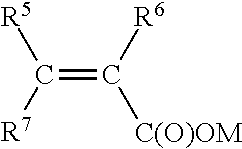Method of reducing stickiness of cementitious compositions
a technology of cementitious compositions and stickiness reduction, which is applied in the field of modification of cementitious compositions, can solve the problems of affecting the smoothness of concrete or mortar, etc., to achieve excellent rheological properties, minimize concrete or mortar stickiness problems, and minimize the effect of concrete or mortar stickiness
- Summary
- Abstract
- Description
- Claims
- Application Information
AI Technical Summary
Benefits of technology
Problems solved by technology
Method used
Image
Examples
example 1
[0075]A three-neck round bottom flask was fitted with a mantle heater, a thermocouple connected to temperature controller and a mechanical stirrer. The reactor was charged with 361 g of de-ionized water, purged with argon gas, then heated to 65° C. A solution of 16.1 g poly(ethylene glycol)methyl ether methacrylate (MPEGMA) having 450 molecular weight polyethylene glycol chain, 106.7 g of poly(ethylene glycol)methyl ether methacrylate (MPEGMA) having 1,100 molecular weight polyethylene glycol chain, 17.3 g of acrylic acid (AA), 1.91 g of 3-mercaptopropionic acid and 176 g of de-ionized water was prepared in advance.
[0076]Separately, a solution of 4.87 grams (g) of ammonium persulfate in 50 g of de-ionized water was prepared. Once the temperature of the reactor reached 65° C., both solutions were added drop-wise over a period of 1.5 hours while stirring. After the addition was completed, the reaction was continued for another 2.0 hours at 68° C.-70° C. and then stopped by cooling to ...
example 2
[0079]This example illustrates the stickiness-reducing effect of the carboxylate polymers of the invention by measuring the flow, flow time, and relative plastic viscosity of concrete. The concrete mix design included the following components: Asia OPC bagged cement—110 kg / m3; slag—320 kg / m3; sand—765 kg / m3; stone—940 kg / m3; water—142 kg / m3 for a water-to-cement ratio of 0.33. The concrete test was conducted in accordance with SS-EN-934 test method for various polymers with the use of a polyalkylene oxide defoamer and prescribed amounts of gluconate and sucrose retarders. The polymer dosage is described as a percentage of weight of active polymer to weight of cement.
[0080]The mixing procedure was as follows: (1) mix sand, stone, and 50% of water for 30 seconds; (2) add the remaining water and mix for 30 seconds; (3) cement and mix for one minute; (3) add polymer and defoamer and mix for three minutes; (4) stop mixer and perform measurements immediately. The flow (in mm) is the avera...
example 3
[0083]In this example, the performance of the carboxylate polymers of the invention were evaluated at higher dosages and higher workability or flow. The test protocol was identical to that described in Example 2. The results are summarized in Table 3.
TABLE 3Properties at 5-minProperties at 60-minRel.Rel.PlasticPlasticFlowViscosityFlowViscosityDosageFlowTime(10−6FlowTime(10−6Admixture(% s / c)(mm)(sec)bar*h / m)(mm)(sec)bar*h / m)Polymer 10.15510179.94753011.6Polymer 20.135201611.645520—Reference0.115202612.74753514.13
[0084]Again, the results in Table 3 confirm that the carboxylate polymers having two different polyether side chains outperformed the Reference polymer even at higher flow.
PUM
| Property | Measurement | Unit |
|---|---|---|
| Fraction | aaaaa | aaaaa |
| Percent by mass | aaaaa | aaaaa |
| Percent by mass | aaaaa | aaaaa |
Abstract
Description
Claims
Application Information
 Login to View More
Login to View More - R&D
- Intellectual Property
- Life Sciences
- Materials
- Tech Scout
- Unparalleled Data Quality
- Higher Quality Content
- 60% Fewer Hallucinations
Browse by: Latest US Patents, China's latest patents, Technical Efficacy Thesaurus, Application Domain, Technology Topic, Popular Technical Reports.
© 2025 PatSnap. All rights reserved.Legal|Privacy policy|Modern Slavery Act Transparency Statement|Sitemap|About US| Contact US: help@patsnap.com



